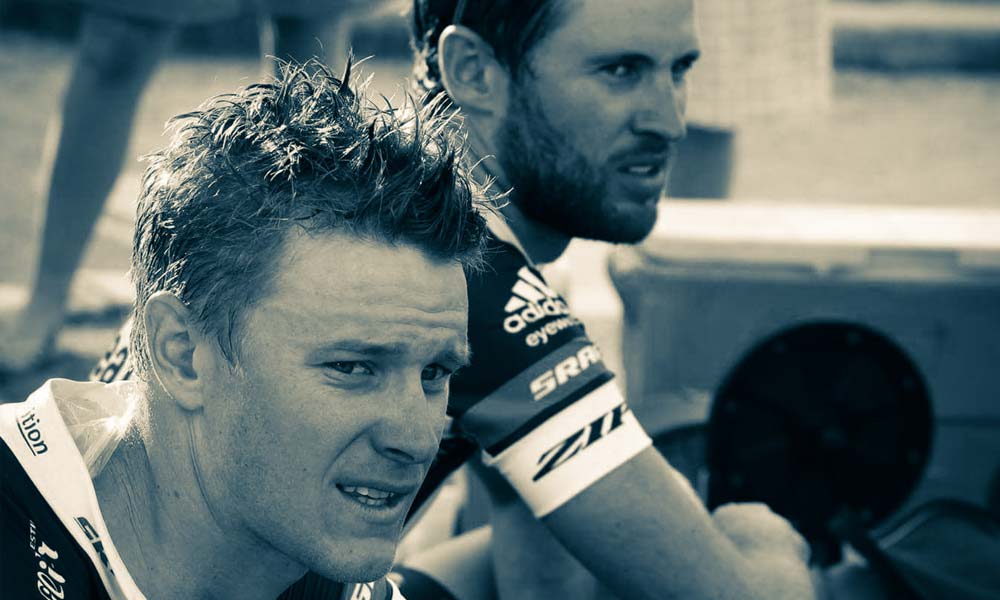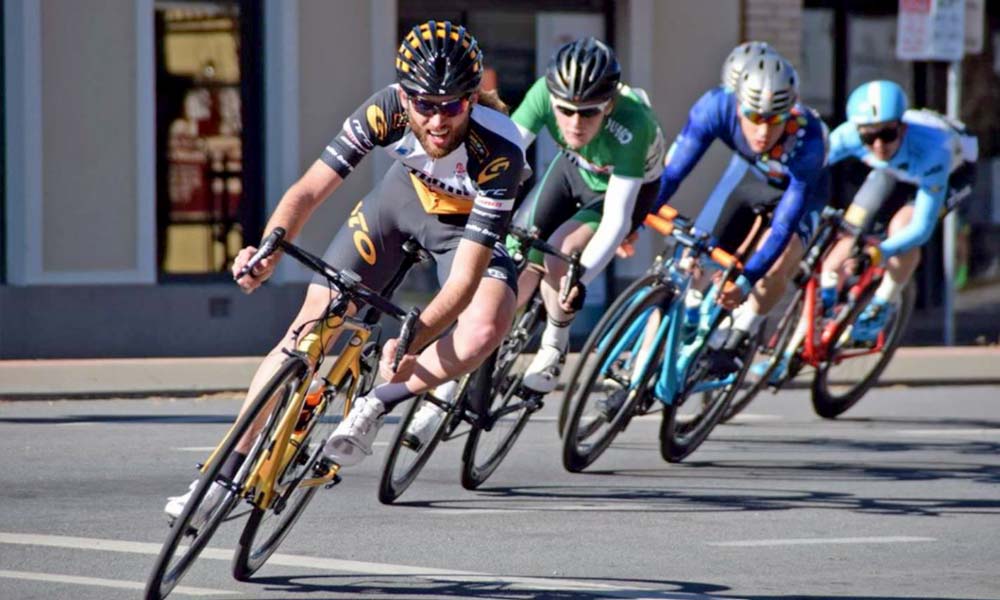[et_pb_section bb_built=”1″ admin_label=”section”][et_pb_row admin_label=”row”][et_pb_column type=”1_4″][et_pb_text admin_label=”Text” background_layout=”light” text_orientation=”left” use_border_color=”off” border_color=”#ffffff” border_style=”solid”]
We continue the series by Tim Guy. In part three, he writes about using the lessons from physical training to assist with mental development.
[/et_pb_text][/et_pb_column][et_pb_column type=”3_4″][et_pb_text admin_label=”Text” background_layout=”light” text_orientation=”left” use_border_color=”off” border_color=”#ffffff” border_style=”solid”]
Adaptation is essential for improvements in cycling and in life.
– By Tim Guy
In my previous article, I introduced Mark Windsor and established his importance to me – not only as a coach, but as and a life mentor and friend. In my final articles, I will look at the specific training Windsor implemented with me from my return to cycling through to the present.
Firstly, it’s important to establish an understanding of the main training principles utilised by Windsor in my early return.
Every training program’s central goal is to induce adaptations, allowing the body to handle higher and higher levels of stress. This is done by presenting the body with a physical training stimulus (stress) and then allowing it to recover.
During recovery, the body adapts to the stress, thinking ‘Stuff me, that was hard – I bet this idiot is going to try and make me do that again, so I better become more efficient.’
However, it is important to remember that this adaptation ONLY takes place AFTER and NOT during a stimulus – recovery is essential.
If stress is presented too often without recovery, fatigue sets in and overtraining can occur.
The segmentation of different periods of training and recovery to layer adaptations in various components of fitness in the attempt to induce optimal performance at a targeted event or competition period is call periodisation.
Windsor utilised periodisation in an attempt not only induce physical adaptations, but to also develop mental adaptations. Not to eliminate or avoid mental stress (extreme anxiety and depression), but to adapt to it, to manage it more and more effectively into the future.
It has never been about attempting to fix or cure my mental illness, rather, everything has been designed with the understanding that my mental illness is part of me.
You cannot eliminate the physical stress of racing, you can only learn to handle it more effectively trough training. I cannot eliminate my mental health issues, but Windsor has helped me to understand that I can learn to manage them better.
Another training principle heavily relied upon by Windsor and one that is important to understand, is individualisation. This principle states that each athlete responds differently to a stimulus and can handle different amounts of stress.
For a program to be its most effective, it must be designed to target specific, individualised adaptations.
Overtraining can occur at different rates for different athletes. It has been a fine balance attempting to understand when too much stress has been placed on my mental capacity and when increased recovery is needed.
* * * * *
[/et_pb_text][/et_pb_column][/et_pb_row][et_pb_row admin_label=”Row”][et_pb_column type=”4_4″][et_pb_image admin_label=”Image” show_in_lightbox=”off” url_new_window=”off” use_overlay=”off” animation=”left” sticky=”off” align=”left” force_fullwidth=”off” always_center_on_mobile=”on” use_border_color=”off” border_color=”#ffffff” border_style=”solid” src=”https://www.ridemedia.com.au/wp-content/uploads/2017/09/TodaysPlan-Tim-Guy.jpg” /][/et_pb_column][/et_pb_row][et_pb_row admin_label=”Row”][et_pb_column type=”1_4″][et_pb_text admin_label=”Text” background_layout=”light” text_orientation=”left” use_border_color=”off” border_color=”#ffffff” border_style=”solid”]
Tim Guy monitored his training workload over the period of several years… (above).
[/et_pb_text][/et_pb_column][et_pb_column type=”3_4″][et_pb_text admin_label=”Text” background_layout=”light” text_orientation=”left” use_border_color=”off” border_color=”#ffffff” border_style=”solid”]
Cycling was something I’d always wanted to do but I left it behind for a while believing that it was causing my mental health problems.
Eventually, in 2012 after nearly four years away from the sport, I came to an understanding that cycling was not – and had never been – the problem. This didn’t mean that anxiety was not still present with cycling, nor that it wasn’t enhanced by the bitterness and disappointment I felt from it driving me away from a sport I loved.
My mental illness meant that I no longer loved anything.
I didn’t so much want to return to cycling, as I came to the belief (although a fickle and anxiety-ridden belief) that the way back to any form of life – if there was a way – was through returning to the sport, by trying to allow it to be part of my life despite the plague of fog that inhabited my soul.
I sent Windsor an email, explaining that I wanted to try and let cycling be part of my life again. He sent me a quick reply, informing me that he planned to read it multiple times before replying. I titled it “The Epic email”.
It was understandable that he needed time to process the mixture of thoughts I’d filled his inbox with.
A week later, I ran into Windsor and his beautiful wife Kerryn in a supermarket carpark in our home town. It was a blazing summer day.
As we stood in the sun, it became apparent that he had not only read the email multiple times, but that he had spent some serious brain power contemplating the best move forward.
We spoke for over an hour – the milk they had bought went off and their ice-cream melted before we finished. My fruit smoothie also lost its appeal; I threw it out on the way back to my car. But it didn’t feel like a waste.
Talking to Windsor, even in my darkest moments, seemed to hold some distant glimmer of hope.
* * * * *
[/et_pb_text][/et_pb_column][/et_pb_row][et_pb_row admin_label=”Row”][et_pb_column type=”4_4″][et_pb_image admin_label=”Image” show_in_lightbox=”off” url_new_window=”off” use_overlay=”off” animation=”left” sticky=”off” align=”left” force_fullwidth=”off” always_center_on_mobile=”on” use_border_color=”off” border_color=”#ffffff” border_style=”solid” src=”https://www.ridemedia.com.au/wp-content/uploads/2017/09/Waiting-for-the-start.jpg” /][/et_pb_column][/et_pb_row][et_pb_row admin_label=”Row”][et_pb_column type=”1_4″][et_pb_text admin_label=”Text” background_layout=”light” text_orientation=”left” use_border_color=”off” border_color=”#ffffff” border_style=”solid”]
Tim Guy (above), fighting back his nerves waiting for a race to start…
[/et_pb_text][/et_pb_column][et_pb_column type=”3_4″][et_pb_text admin_label=”Text” background_layout=”light” text_orientation=”left” use_border_color=”off” border_color=”#ffffff” border_style=”solid”]
The car park conversation about “The Epic Email” had established the goals and training of my initial return. It was marked by one central goal and two sub-goals.
The main goal was to learn to allow cycling to be part of my life, it was not necessarily about attempting to race again rather just about accepting that cycling was, and could still be, part of me – even if it couldn’t be in the way I had originally planned.
The first sub-goal didn’t involve a bike. It was to go out for coffee with some of the younger and more eager cyclists in the club. Windsor knew that I would battle with this. That seeing riders loving the sport when I could barely get myself on a bike cut me to the core. However, if I could learn to allow them their enthusiasm, then I could turn my attention to my own situation.
I was allowed to be different – my experience was allowed to be different, but so were their experiences.
The second goal, was to ride three days a week. It didn’t matter how far I rode; in fact, all I had to do was to kit up and roll out the door. I could (and did many times) turn around at the end of the driveway and go back inside. The idea was to get used to the routine, to adapt to the idea of getting ready for a ride.
* * * * *
[/et_pb_text][/et_pb_column][/et_pb_row][et_pb_row admin_label=”Row”][et_pb_column type=”1_2″][et_pb_text admin_label=”Text” background_layout=”light” text_orientation=”left” background_color=”#0eedf4″ use_border_color=”off” border_color=”#ffffff” border_style=”solid” custom_padding=”10px|10px|10px|10px”]
Tim Guy: cycling and mental health (part 01)
[/et_pb_text][/et_pb_column][et_pb_column type=”1_2″][et_pb_text admin_label=”Text” background_layout=”light” text_orientation=”left” background_color=”#0eedf4″ use_border_color=”off” border_color=”#ffffff” border_style=”solid” custom_padding=”10px|10px|10px|10px”]
Tim Guy: cycling and mental health (part 02)
[/et_pb_text][/et_pb_column][/et_pb_row][et_pb_row admin_label=”Row”][et_pb_column type=”1_4″][et_pb_text admin_label=”Text” background_layout=”light” text_orientation=”left” use_border_color=”off” border_color=”#ffffff” border_style=”solid”]
[/et_pb_text][/et_pb_column][et_pb_column type=”3_4″][et_pb_text admin_label=”Text” background_layout=”light” text_orientation=”left” use_border_color=”off” border_color=”#ffffff” border_style=”solid”]
At the very end of 2012, I was offered a job teaching at Orange High School for 2013. In December I attended a staff development day to prepare myself for the following year. During a lunch break, and halfway through a school-funded lamington, I received a phone call.
The call I received was from the owner of the NRS team search2retain, Peter Shandon. A close mate, Angus Tobin, had returned from two years racing in Belgium and had signed with Shandon’s team. They were still looking for another rider for 2013 and Angus, knowing I had begun riding my bike again (even if it was just down the driveway and back), suggested they talk to me.
I informed Peter of my situation. I told him all of it. He rang me back the next day. I don’t know who he talked to but, with a mixture of excitement and dread, he told me “we want you on the team”.
Windsor, in his ever-creative coaching style, convinced me that it was more an opportunity to learn to allow others to pursue contracts, strive for results and even for them to love racing. It was another opportunity to allow me to accept that their experiences were different to mine but that this didn’t mean cycling could not also be part of my life. It was like an opportunity to say a proper farewell to the racing side of the sport.
* * * * *
My training throughout 2013 was characterised by riding the 10km journey to work at the school and then back home, four days a week, along with the occasional appearance at a Bathurst Club race.
The first two NRS races I was meant to do with the team didn’t happen. I pulled out beforehand due to unavoidable dread.
For two days, I fought for the courage to call Pete to tell him that I could not do it, that I was too overcome with panic. Making the call was just as terrifying as the thought of racing.
Yet, still later in the year, the team offered me spots in other races.
There was no expectation on me. It was simply an opportunity for me to process more effectively what had been an abrupt departure from the sport. By the end of the season I’d started three NRS stage races and finished all three.
The other riders on the team knew my situation and were incredibly supportive, particularly Angus. He looked out for me at races, helping me to find some slithers of enjoyment amongst the fear.
– By Tim Guy
[/et_pb_text][/et_pb_column][/et_pb_row][/et_pb_section]





